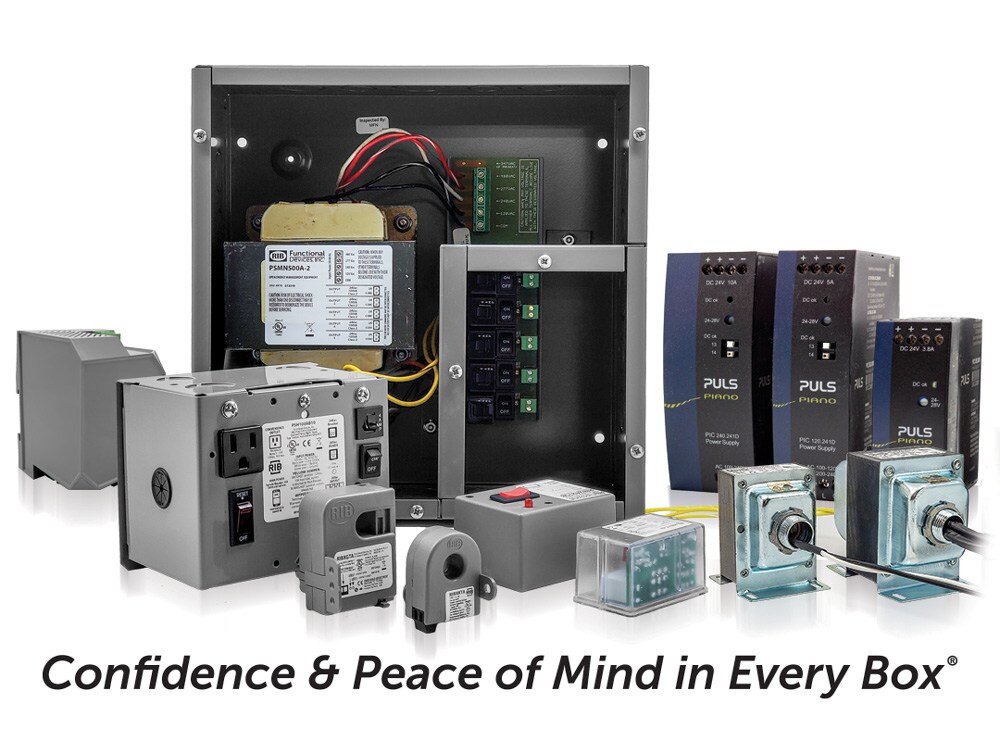If you’ve never heard of Internet-of-Things (IoT)-enabled current sensors, now is the time to listen up because you’ll be seeing IoT-enabled current sensors used a lot more often as smart buildings become the norm. It makes sense that they would, too, since they’ve already started to change the way commercial industries handle energy management for the better.
The unparalleled real-time power monitoring of IoT-enabled current sensors allows for more efficient, sustainable, reliable, predictive, and automated energy management, which benefits business owners. Let’s explore some of those benefits and the top ways that IoT-enabled current sensors are helping to revolutionize commercial spaces.
IoT-enabled devices can be essential in a larger ecosystem: your building automation system (BAS). Functional Devices takes pride in offering many components for a BAS, including our pre-packed and preassembled “Relay In a Box®.” Contact us to learn more about what we offer.

Real-Time Power Monitoring and Visibility
Wouldn’t it be nice to know immediately at any given moment how much electricity your building is consuming? With IoT-enabled current sensors, you can. Real-time power monitoring is one of the simplest ways these devices are revolutionizing energy management.
IoT current sensors continuously collect and measure electrical currents, transmitting that data wirelessly to a central platform where a person can easily view, monitor, and analyze energy consumption.
This real-time data gives a facility manager a better view and understanding of energy usage across the building, allowing for more informed decisions and optimization. Identifying inefficiencies and reducing waste becomes much easier with a comprehensive, up-to-date view of energy consumption.
For example, an HVAC system in a commercial building with varying environments and window placements shouldn’t perform the same between floors and departments. Instead, managers can use the data from IoT current sensors to optimize the HVAC for different areas and their unique needs.
Predictive Maintenance and Fault Detection
IoT current sensors also provide the data necessary for early fault detection. Since these sensors continuously monitor electrical currents, they have a clear baseline established and can flag any significant deviations through AI-driven algorithms.
Unusual patterns may indicate a malfunctioning device or one that is about to, which allows facility managers to perform proactive maintenance and early detection of issues. Problems that might be avoided include:
- Overloaded circuits
- Motor failures
- Power surges
- Loose connections
Predictive maintenance ultimately reduces device downtime and maintenance costs. Let’s continue using HVAC as an example; an IoT current sensor could detect and help prevent a motor from overheating, thus extending the system's lifespan.
Demand Response and Load Optimization
Like the “auto” setting on many home appliances, you want your building’s systems to respond dynamically to energy demands and adjust power loads appropriately. Enter the next way that IoT-enabled current sensors are revolutionizing energy management.
With their real-time data of electrical currents, IoT current sensors play an essential role in effective demand response, allowing a building to adjust automatically to fluctuating grid conditions.
Effective demand response and load optimization ensure better grid stability and lower operational costs. Remember our HVAC example? Thanks to IoT current sensors (and other parts of your BAS!), it can adjust automatically during high-demand periods, saving you money and lowering energy use.
Enhanced Energy Efficiency and Cost Savings
Speaking of saving you money and lowering energy consumption, a big way that IoT current sensors are changing energy management is by improving a building’s energy efficiency and reducing operational expenses. How? It all goes back to that real-time data.
We have already mentioned that real-time electricity usage data can help identify inefficiencies and inform decision-making. Sensors can show which systems use the most power and when, pinpointing where a building automation system (BAS) might need adjustments. For example, this could look like:
- Eliminating phantom loads
- Setting up lighting controls based on occupancy patterns
- Turning off systems when unnecessarily consuming power (like an HVAC system overnight)
These are some ways real-time data from IoT current sensors can improve efficiency and save you money.
Sustainability and Carbon Footprint Reduction
Finally, IoT current sensors help achieve sustainability initiatives and reduce a building’s carbon footprint. As outlined above, real-time data, predictive analytics, demand forecasting, and better efficiency all enhance a building’s overall sustainability.
Additionally, IoT current sensors can integrate with renewable energy sources for smarter energy distribution. For example, electricity usage data from current sensors can help a facility manager decide how to balance solar power generation with grid energy.
IoT-Enabled Device Use to Grow
IoT-enabled current sensors are transforming how we manage energy consumption in commercial facilities. Their real-time data allows for improved efficiency, safety, and efficacy. We expect to see more widespread adoption of IoT technologies across all industries as business owners learn the power of going smart.
Here at Functional Devices, we strive for quality and innovation in our BAS equipment. Explore some of our intelligent field devices, and reach out to us with any questions!
About Functional Devices, Inc.

Leaders in the Industry
The world was a very different place in 1969, when Functional Devices, Inc. was founded by engineer and electronics enthusiast Albert Rittmann, but our commitment to evolution and versatility has allowed us to remain a key player in the building automation and lighting controls industry for over 55 years.
Today, as we embrace emerging technology and lean into the future of building automation, our products are still manufactured in the USA with global materials, and we are still committed to our mission of enhancing lives in buildings and beyond. Back in 1969, Albert could never have predicted the technological advances we live with today, but with the groundwork he laid and the vision of his successors, Functional Devices has adapted and grown into a company that can handle anything.